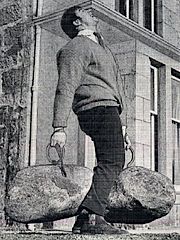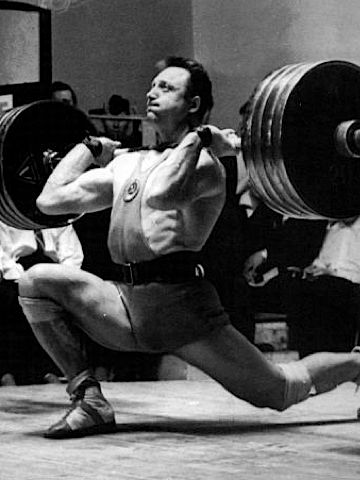 It's nearly the end of a week in the sun (for me, at least). In my absence, a few of my favourite articles from the Straight to the Bar archives :
It's nearly the end of a week in the sun (for me, at least). In my absence, a few of my favourite articles from the Straight to the Bar archives :
- 8 cups per day
- Holding the bar in the Front Squat
- The Step-up : a real Squat alternative?
- Biphasic sleeping
- DIY : Home-made gym equipment
- Straight to the Grip Contest
- Bonus : Normal programming resumes tomorrow. In the meantime, take a look at this clip via Napalm's Corner. A great angle, amazing control. Superb.
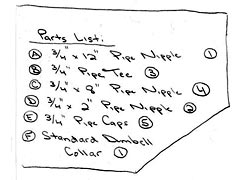



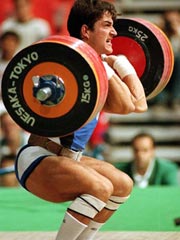
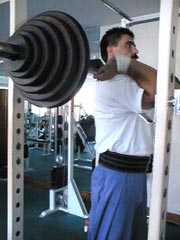 This is generally considered the optimum position - if you have the option, do it this way.
This is generally considered the optimum position - if you have the option, do it this way.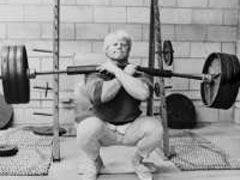 Another common method is to cross the arms over the bar, holding the left side with the right hand and vice versa. If the abovementioned Clean method is out of the question for you, try this.
Another common method is to cross the arms over the bar, holding the left side with the right hand and vice versa. If the abovementioned Clean method is out of the question for you, try this.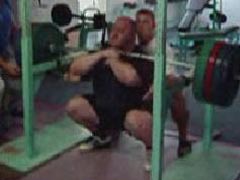 Whilst frowned upon by many purists, this technique is still used occasionally. Clasp your hands together and use them to push the bar onto your chest/front delts.
Whilst frowned upon by many purists, this technique is still used occasionally. Clasp your hands together and use them to push the bar onto your chest/front delts.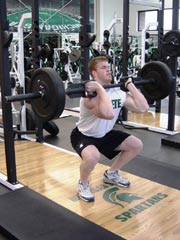 A much less common version (but intriguing nonetheless) is the Log Bar Front Squat. As you can see, a log bar prompts a vertical grip, which takes a similar amount of flexibility as the Clean grip.
A much less common version (but intriguing nonetheless) is the Log Bar Front Squat. As you can see, a log bar prompts a vertical grip, which takes a similar amount of flexibility as the Clean grip.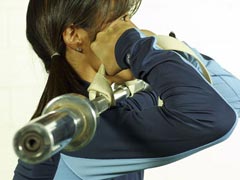 I noticed this yesterday in Mike Boyle's article
I noticed this yesterday in Mike Boyle's article 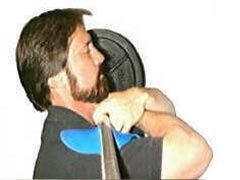 The Stringray device is designed to counter the basic deficiencies of the crossed arms approach. The two pads help keep the bar aligned and stable, allowing the widest possible grip to be used. The Stingray also lifts the bar slightly, keeping the weight over the front delts whilst keeping it away from your throat.
The Stringray device is designed to counter the basic deficiencies of the crossed arms approach. The two pads help keep the bar aligned and stable, allowing the widest possible grip to be used. The Stingray also lifts the bar slightly, keeping the weight over the front delts whilst keeping it away from your throat.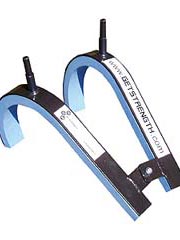 The
The 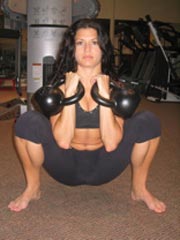 Got two kettlebells? Try this. Remember to Clean them one at a time.
Got two kettlebells? Try this. Remember to Clean them one at a time.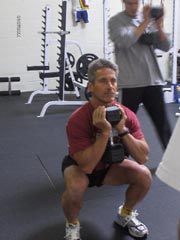 The Goblet Squat is often considered a separate exercise, however I've included it here for completeness. It can be performed either using a dumbbell as shown, or by grabbing a kettlebell 'by the horns'.
The Goblet Squat is often considered a separate exercise, however I've included it here for completeness. It can be performed either using a dumbbell as shown, or by grabbing a kettlebell 'by the horns'.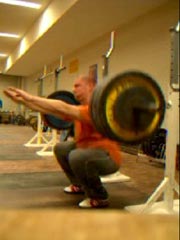 If none of the different holds shown above appeal, there's always the 'hands free' method (thanks
If none of the different holds shown above appeal, there's always the 'hands free' method (thanks 
 This is generally considered the optimum position - if you have the option, do it this way.
This is generally considered the optimum position - if you have the option, do it this way. Another common method is to cross the arms over the bar, holding the left side with the right hand and vice versa. If the abovementioned Clean method is out of the question for you, try this.
Another common method is to cross the arms over the bar, holding the left side with the right hand and vice versa. If the abovementioned Clean method is out of the question for you, try this. Whilst frowned upon by many purists, this technique is still used occasionally. Clasp your hands together and use them to push the bar onto your chest/front delts.
Whilst frowned upon by many purists, this technique is still used occasionally. Clasp your hands together and use them to push the bar onto your chest/front delts. A much less common version (but intriguing nonetheless) is the Log Bar Front Squat. As you can see, a log bar prompts a vertical grip, which takes a similar amount of flexibility as the Clean grip.
A much less common version (but intriguing nonetheless) is the Log Bar Front Squat. As you can see, a log bar prompts a vertical grip, which takes a similar amount of flexibility as the Clean grip. I noticed this yesterday in Mike Boyle's article
I noticed this yesterday in Mike Boyle's article  The Stringray device is designed to counter the basic deficiencies of the crossed arms approach. The two pads help keep the bar aligned and stable, allowing the widest possible grip to be used. The Stingray also lifts the bar slightly, keeping the weight over the front delts whilst keeping it away from your throat.
The Stringray device is designed to counter the basic deficiencies of the crossed arms approach. The two pads help keep the bar aligned and stable, allowing the widest possible grip to be used. The Stingray also lifts the bar slightly, keeping the weight over the front delts whilst keeping it away from your throat. The
The  Got two kettlebells? Try this. Remember to Clean them one at a time.
Got two kettlebells? Try this. Remember to Clean them one at a time. The Goblet Squat is often considered a separate exercise, however I've included it here for completeness. It can be performed either using a dumbbell as shown, or by grabbing a kettlebell 'by the horns'.
The Goblet Squat is often considered a separate exercise, however I've included it here for completeness. It can be performed either using a dumbbell as shown, or by grabbing a kettlebell 'by the horns'. If none of the different holds shown above appeal, there's always the 'hands free' method (thanks
If none of the different holds shown above appeal, there's always the 'hands free' method (thanks 